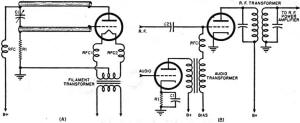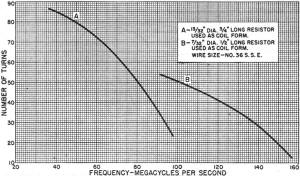As radio frequencies moved up into the
UHF
realm of 30 MHz (through 3 GHz),
designers noticed that the old methods and equations for winding
inductors (aka coils and chokes)
no longer performed as predicted. The culprit was stray capacitance
created by the wire itself and the insulation between windings.
To some extent, the length of leads running from the inductor
windings to connection points (terminal
strips and lugs at first and then later printed circuit boards)
generated enough extra inductance to add noticeably to total
inductance. New methods were developed to help mitigate the
effects of these stray (aka parasitic)
reactances. Much new knowledge in this area was gained through
the war efforts with many radar and radio designs coming online
during the time.
R.F. Chokes at U.H.F.
By W. J. Stolze
With the assignment of many services to higher frequencies,
the electrical characteristics of component parts must be carefully
analyzed.

Fig. 1. Photographs of several r.f. chokes
that can be used depending on the operating frequency. (1) Broadcast
type coil, used effectively up to 10 mc. (2) Used extensively
at frequencies from 10 to 180 mc. (3) Air-core type solenoid
used at higher frequencies.
With the advent of FM and television, the radio serviceman,
who for the past twenty-odd years has been ably repairing amplitude-modulated
(AM) broadcast receivers, must now familiarize himself with
good design and construction technique in the recently assigned
high-frequency bands. A thorough working knowledge of the various
problems which become apparent at high frequencies will not
only increase the pleasure that a radio amateur can extract
from his hobby, but will also be very profitable, for in the
immediate future the majority of sets brought into the small
service station for repair will be high frequency FM and television
receivers. With an eye to the future, this article will discuss
the design and application of radio frequency chokes in the
new v.h.f. bands.
The proper selection of a correct r.f. choke, even though
often ignored, misunderstood, and underemphasized, is an important
factor in obtaining the best possible performance from a well-designed
unit of equipment. The most important circuit application of
the choke is in series with the B+ plate voltage supply of high-frequency
oscillators. In Fig. 3A a typical FM local oscillator is shown.
The choke, RFC1 is inserted in series between the
plate of the tube and the B+ voltage supply. At the frequencies
used, if this choke were not present a portion of the available
power output of the oscillator would be dissipated in the plate
power supply. This is a serious situation when maximum power
output is required. The condition can be equated as follows:
Power Output = Power Available - Power Dissipated
A typical circuit uses the 6C4 and is capable of delivering
about four watts maximum output. With improper choking, as much
as two watts may be lost in the power pack, leaving only two
watts, or 50% maximum power, available as useful output. This
condition also exists and is even more serious in high power
transmitter oscillators.
Fig. 3A also includes a choke, RFC2, in the grid-leak
circuit. Most setups require this choke, as its omission may
be cause for the oscillator to cease operation. A diagram of
the typical grid-leak resistor is shown in Fig. 3B. A carbon
rod forms the resistive element, which is flanked on each side
by small round metal plates, A and B from which the terminal
leads are brought out. Bakelite or ceramic covering is added
as insulation. A stray capacity exists between these plates,
A and B, which at high frequencies may be of such magnitude
as to bypass enough of the signal from the grid to ground to
prevent oscillation.
In the 200 to 600 megacycles per second section of the frequency
spectrum, transmission lines make then appearance as tuned circuits
for power oscillators. At these frequencies another problem
appears. High percentages of the power may run down the leads
of the filament and be lost in the filament transformer. Correction
of this condition is essential since the same problem exists
as did with improper plate supply chokes. Fig. 2A illustrates
the application of r.f. chokes in the filament leads, and one
of a number of correct methods of grounding. As the frequency
approaches 600 megacycles, and above, however, it becomes convenient
to feed the heaters through tuned transmission lines, which
then act as r.f. chokes.

Fig. 2. (A) In higher frequency applications
r.f. chokes must be employed in the filament circuits to prevent
oscillations. Proper method of grounding is shown. (B) Circuit
for grid bias modulation. R.f. choke prevents r.f. from entering
modulation transformer.
Confining r.f. to particular sections of a circuit and eliminating
it in other sections is another use to which r.f. chokes are
put in modulating apparatus. In Fig. 2B a circuit for grid-bias
modulation is shown. Here the r.f.c. prevents the r.f. from
flowing in the modulating transformer.
Of course there are many other applications of r.f. chokes,
but those which are most important and those which the average
radio serviceman or radio ham are most likely to encounter have
been included in the above discussion.
An important characteristic of chokes which is very often
forgotten or ignored is that the choke must be a very high impedance
at the operating frequency and not just a high inductance. If
this condition is not fulfilled a serious detuning of the tank
circuit may result. This statement at first appears paradoxical,
but can be easily explained with reference to Fig. 5. It shows
a number of coils of wire wrapped around a Bakelite form. Small
capacities (distributed) exist between each pair of turns on
the coil. Classically a condenser consists of two flat plates
of a conducting material separated by an insulating dielectric.
In this case the two turns of wire form the plates and the interspace
air forms the insulator. A condition of this nature exists with
every coil. Even though the distributed capacity is small, it
is impossible to make it zero; therefore, the optimum in choke
design appears when the inductance of the coil resonates with
its own distributed capacity at the operating frequency.

Fig. 3. (A) Diagram of FM local oscillator,
shows most common application of r.f. chokes. (B) Common grid-leak
type resistor.
In actual practice, self-resonance is almost impossible to obtain
exactly, because stray capacities which arise in the circuit
wiring almost always detune the choke somewhat, but a condition
as close as possible to the goal will pay the highest dividends.
Too many turns will result in a very large stray capacity and,
at a frequency any appreciable amount above resonance, the choke
will appear to be a shunt condenser.
A Boonton Q Meter is an excellent instrument on which to
measure resonant frequencies of chokes, but since such an instrument
is expensive and therefore not available to the average amateur,
several graphs are included to aid in the design of high-frequency
chokes.
Other characteristics of chokes that are important are the
current carrying capacity of the wire, which must be high enough
for the desired application, and the resistance of the choke,
which must be low enough not to cause an appreciable voltage
drop.

Fig. 4. Design chart shows approximate number
of turns vs. frequency for r.f. chokes.
Remembering this construction hint will save many hours of
time search-ing for the cause of trouble in new FM sets.
Now for a sample design of a choke.
Sketches of several chokes used at various frequencies are
pictured in Fig. 1. Type 1 is used mainly in the broadcast band
and up to approximately 10 megacycles. Construction of this
of choke is difficult, as it necessitates the application of
a universal coil-winding machine and is therefore out of the
scope of most amateurs and radio builders. Choke number 2 is
useful for frequencies from about 10 megacycles up to about
180 megacycles. Above this frequency, air-cored solenoids, type
3, are used.
Ceramic insulated resistors, with values ranging from 1 megohm
up, provide the best form on which to wind a home-constructed
choke. This material has about the least losses of any readily
available. Isolantite is used commercially, but this is essentially
the same thing. The 1-megohm resistance is high enough so that
its effect upon circuit Q's is negligible. Another advantage
of a resistor is that its terminal leads are excellent in facilitating
the use of short connections.
All choke connections at high frequencies should be as short
as it is possible to make them. This point cannot be overemphasized,
as long leads add dangerous amounts of inductance and capacitance
at the frequencies used in the new FM band.
An excellent illustration of this condition can be shown
by the following analogy: A lead 1" long at 100 megacycles has
the same inductive reactance that a lead 8'4" long has at standard
broadcast frequencies. How absurd it is to think of hanging
an 8-foot connection lead in an AM receiver.

Fig. 5. Distributed capacities that will
have effect on the operation of choke.
Let's say a choke is desired for the plate circuit of a local
oscillator of an FM set (Fig. 3A). An excellent high-frequency
oscillator tube is the Radiotron 6C4 miniature triode. The first
factor that comes into consideration is the current that the
plate will draw at maximum output. In the design chart shown
in Fig. 4, values are given for chokes wound on two different
sized cores, using No. 36 single silk enamel wire. The No. 36
wire can carry 25 milliamperes. One watt, 13/32" -diameter,
and one-quarter watt, 7/32" diameter, ceramic insulated resistors
are the two sizes of forms covered by the chart. Plate current
in a small receiving tube is generally not over 25 milliamperes,
so the No. 36 wire will suffice for this circuit.
A point in the middle of the band is the optimum frequency
to choose for the design. The present band is 88 to 108 megacycles;
therefore, 98 mega-cycles will be the design frequency for our
choke. On the chart, using a 7/32" form, it can be seen that
51 turns will fulfill the specifications.
To begin construction, sandpaper the marking paint off
the body of the resistor and solder one end of the wire to a
terminal lead. After winding the required number of turns, cut the wire
to size and fasten it to the other lead with solder, being careful
to keep the coil tight, neatly wound, and closely spaced. If
the design chart has been followed with any degree of accuracy,
a choke has been made that is applicable in either the plate
or the grid leak circuit of the oscillator, RFC, and RFC, of
Fig. 3. Two identical coils should be wound.
All the design and construction de-tails presented in this
article are important. Following them will not insure success,
of course, but it will certainly be a tremendous aid. The following
are a number of general construction rules
for u.h.f. work:
1. Keep all leads as short as possible;
2. Construct the chassis, circuit. and other parts sturdily;
3. Do not use inferior components. Even though u.h.f. is
a new field, the amateur or radio serviceman should not hesitate
for a moment to enter it, for it is an unexplored wilderness
with great opportunities for fascinating home research.
Posted May 15
































